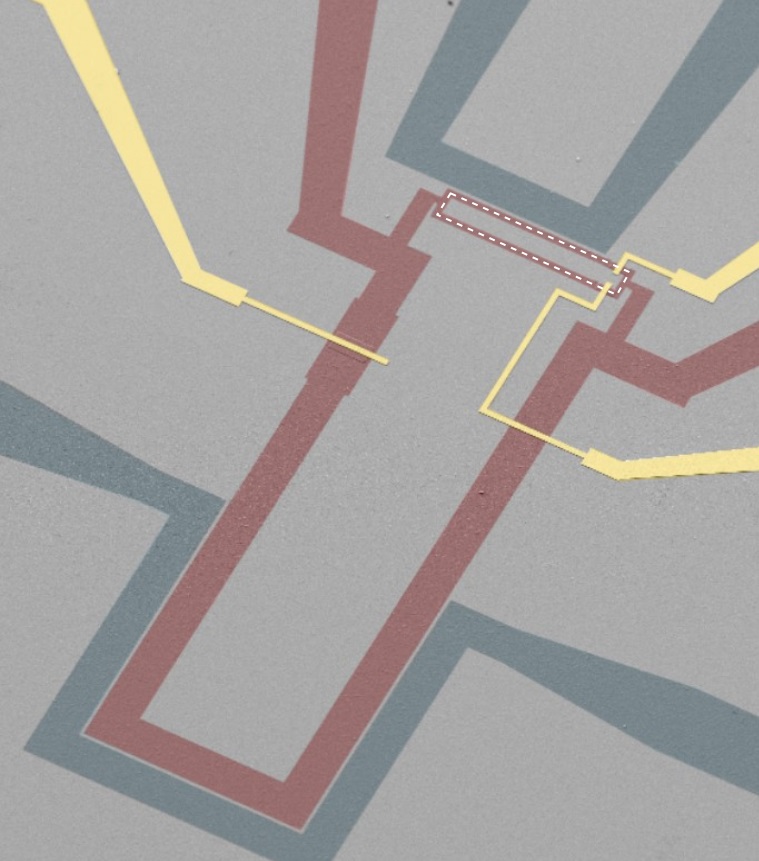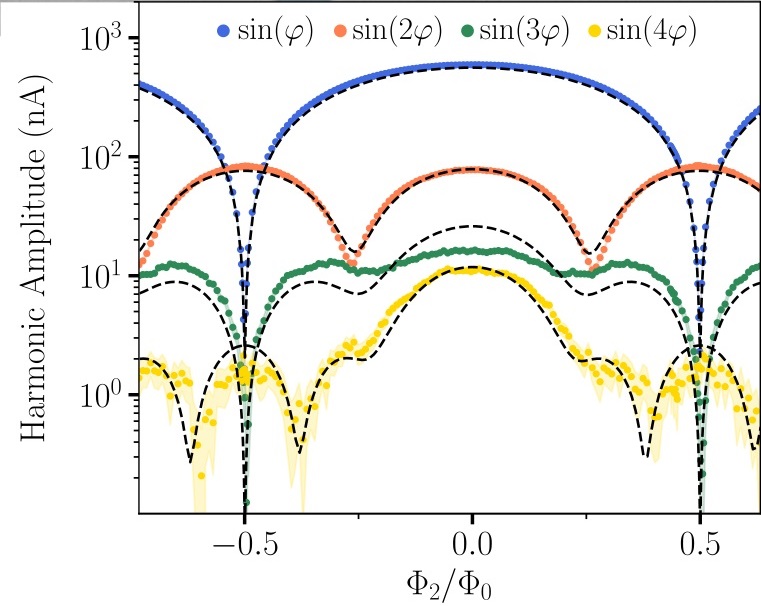For several years, the
LaTEQS team at
PHELIQS has been dedicated to study the electronic properties of germanium layers a few nanometers thick embedded in a SiGe substrate. These layers exhibit exceptional qualities, with charge carrier mobilities (here, holes) reaching several hundred thousand cm²/V/s and an elastic mean free path in the order of microns. They are fabricated at CEA-LETI as 200 mm diameter wafers, then patterned using the
PTA clean room facility for the design of quantum devices such as spin qubits and superconducting transistors. Through a series of three recent publications and as many PhD theses, we have developed the manufacturing processes for superconducting transistors, studied in detail the properties of the non-dissipative current induced by the field effect in the Ge channel, and fabricated our first superconducting qubit.
The superconducting transistors we design, consist of a germanium channel (a semiconductor material) a few hundred nm long and connected to two aluminum superconductors (source and drain). The device is completed by an electrostatic gate that covers the channel, allowing control of the current flowing through it. This operation is similar to the silicon transistors used in cell phones. We exploit the properties of germanium at very low temperatures (T < 1K) when the aluminum contacts become superconducting. Thanks to the exceptional quality of the electrical contact between the aluminum and germanium, it becomes possible to induce superconducting correlations in the channel, thus making it itself "superconducting," i.e., without energy dissipation. We have thus developed a "perfect" transistor which, in its OFF state (positive gate voltage), does not conduct, and which, in its ON state (negative gate voltage), conducts without resistance. This transistor therefore generates no electrical heat dissipation (Joule effect).
The main objective of our work is to deepen our understanding of the properties of this non-dissipative current (supercurrent) and to create our first quantum circuit based on this type of transistor.
Quantum mechanics applied to this type of circuit tells us that there is a relationship between the macroscopic phases of the two superconducting contacts and the supercurrent amplitude (first Josephson relation). When the link between the two contacts is a tunnel barrier, this relationship takes the form of a pure sinusoidal function. This phenomenon (the Josephson effect) forms the basis of superconducting quantum circuits such as those developed by companies like Google, IBM, Rigetti, in France within the start-ups Alice&Bob and SilentWave, and in numerous academic laboratories.
We recently demonstrated that, in the case of our devices called JoFETs (Josephson Field Effect Transistors), this relationship is more complex and involves higher harmonics [1]. This phenomenon demonstrates the very good electrical quality of the source-drain interfaces with germanium. We then developed a first device composed of two JoFETs integrated in a small superconducting loop (SQUID) [2]. Through interference effects obtained by modulating the magnetic flux through this loop, it is possible to control the amplitude of the supercurrent and manipulate its different harmonics. We thus developed the equivalent of a JoFET whose first harmonic can be reduced by 95% (see figure). This phenomenon indicates that the non-dissipative current is no longer carried by Cooper pairs but by pairs of pairs, opening the way to new types of superconducting qubits, potentially better protected than those based on tunnel junctions.
To this end, we have produced a first superconducting qubit from a single JoFET [3]. The geometry of this qubit is inspired by superconducting qubits based on tunnel junctions (transmon), composed of a superconducting island connected to a JoFET, itself coupled to a microwave resonator for reading the qubit state. Using circuit quantum electrodynamics (cQED) techniques, we demonstrated the coherent control of the qubit's quantum states using microwave signals. We also measured the impact of gate control on the qubit states, by evaluating its coherence times. Although these times are still modest (in the order of a few tens of nanoseconds), this advance paves the way for qubits whose protection and coherence times should be considerably improved.

Scanning electron microscopy image of the double SQUID allowing the measurement of the harmonics of the current-phase relationship of the device consisting of a superconducting loop and two Ge superconducting transistors (dotted lines).

The experimental curves show the harmonic decomposition as well as the model adjustment as a function of the magnetic flux through the loop.
Fundings
These studies were partly funded by the ANR SUNISIDEuP project, the PEPR RobustSuperQ and Labex LANEF.